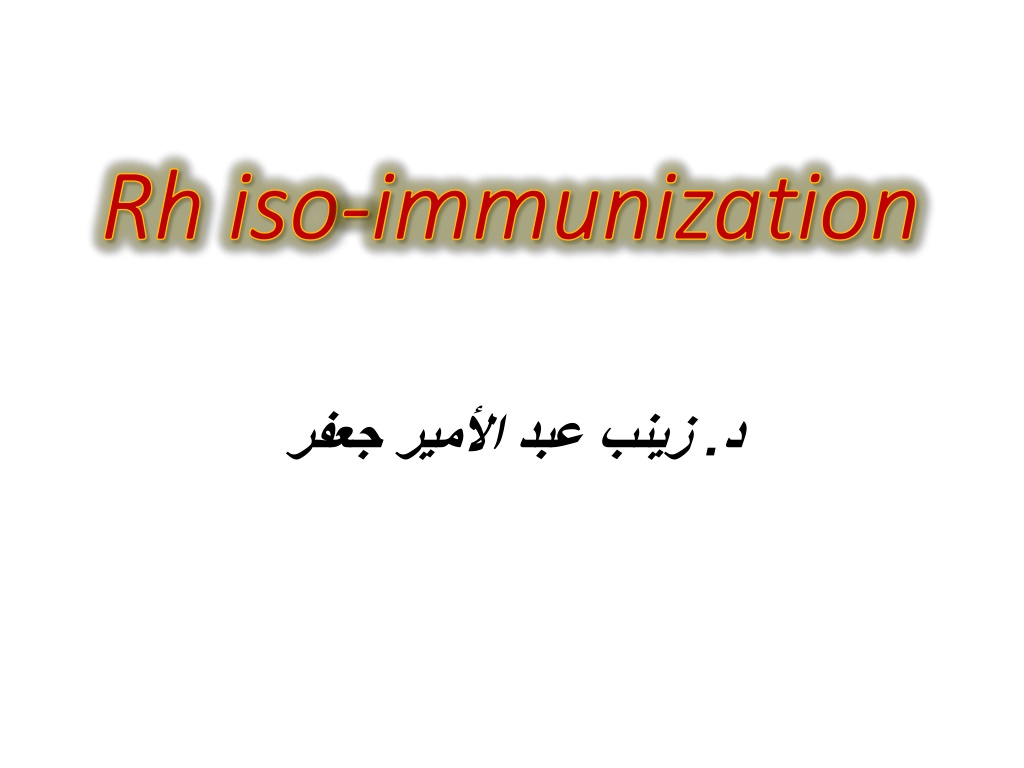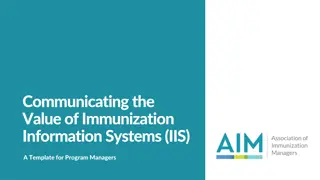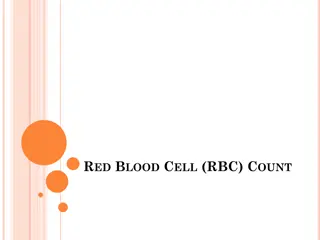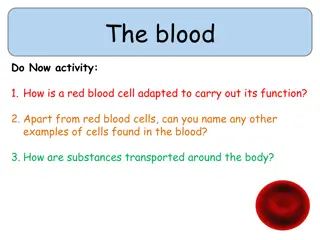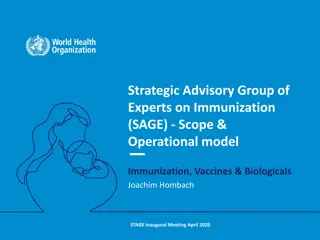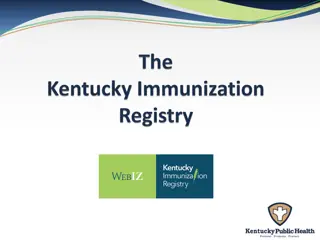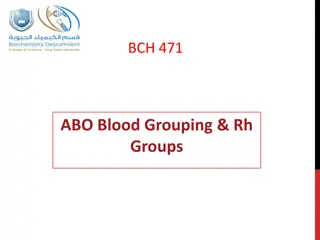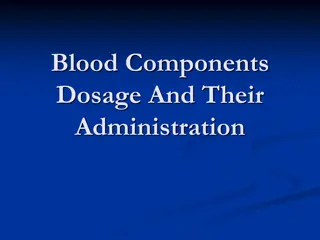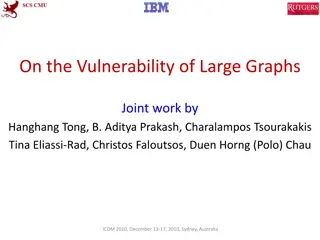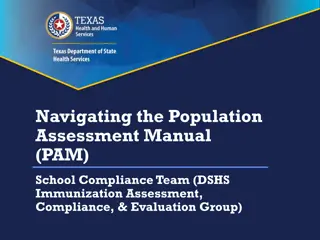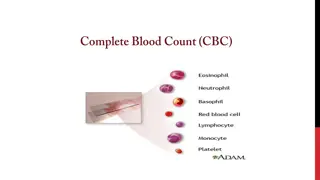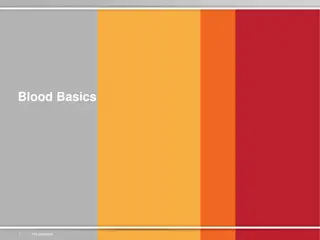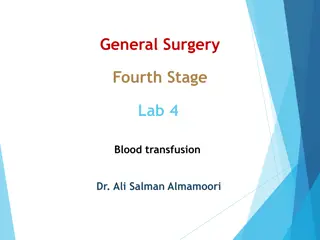Understanding Rh Immunization and Blood Group Incompatibility
Rh immunization and blood group incompatibility can lead to serious complications in fetuses and newborns. The ABO and Rhesus systems play crucial roles in determining blood group compatibility. Rh-positive red cells of the fetus entering the maternal circulation can trigger immune responses, leading to hemolytic disease of the newborn. Complications such as Hydrops fetalis and intrauterine fetal...
Download Presentation

Please find below an Image/Link to download the presentation.
The content on the website is provided AS IS for your information and personal use only. It may not be sold, licensed, or shared on other websites without obtaining consent from the author. Download presentation by click this link. If you encounter any issues during the download, it is possible that the publisher has removed the file from their server.
E N D
Presentation Transcript
Rh Rh iso iso- -immunization immunization .
Blood group is defined in Blood group is defined in 2 2 ways: ways: ABO group (O, A, B, AB). Rhesus system (C, D, E antigens).
ABO group ( ABO group (O, O, A, A, B, B, AB). AB). About 20% of all infants have an ABO maternal blood group incompatibility but only 5% are clinically affected. Because antibodies are (IgM)( cannot cross the placenta and therefore cannot gain access to fetal erythrocytes) Hemolytic disease of the newborn (HDN) due to ABO incompatibility less severe than Rhesus incompatibility.
Rhesus system ( Rhesus system (C, C, D, D, E antigens). E antigens). This system includes five red cell proteins or antigens: c, C, D, e, and E. No d antigen. The presence or absence of D antigen site determines whether an individual is Rh positive or Rh negative. The incidence of Rh-negative genotype is 15% in UK
Pathology of rhesus Pathology of rhesus isoimmunization isoimmunization 1. Rh-positive red cells of the fetus enter into the maternal circulation 2. the first immune response in the mother is the formation of IgM antibodies (they do not cross the placenta) and therefore the first baby is usually unaffected. 3. Subsequent antigen exposure leads to an increased response and IgG formation in the mother, which does cross the placenta and destroy the fetal red blood cells (RBC) leading to reticulocytosis, anemia, heart failure and hydrops.
The first child is generally not The first child is generally not affected because: affected because: fetomaternal hemorrhage occurs late in pregnancy or during delivery and antibody response slowly (over 2 6 months) The initial maternal immunoglobulin M (IgM) antibody are formed, which do not cross the placenta.(molecular weight that is too large to cross the placenta)
What are the fetal and neonatal What are the fetal and neonatal complications that may occur when complications that may occur when mother is immunized? mother is immunized? 1. Hydrops fetalis. 2. Intrauterine fetal death or early neonatal death due to cardiac failure. 3. Icterus gravis neonatorum. 4. Congenital anemia of the newborn.
Prevention of rhesus Prevention of rhesus iso immunization: immunization: During pregnancy routine antenatal prophylaxis with anti-D : All women who are RhD ve are offered anti-D prophylaxis 500 iu at 28 and 34 weeks regardless of sensitizing events or previous administration of anti-D. iso- -
After the potentially sensitizing event a dose, anti-D Ig should be given as soon as possible but always within 72 hours. If it is not given it can be taken within 10 28 days may provide some protection. if <20 weeks, 250 IU of anti-D given IM if >20 weeks, 500 IU of anti-D given IM A Kleihauer test should be performed. Further anti-D can be given if indicated by this test.
the KleihauerBetke test: it is screening test should be performed within 2 hours of delivery to identify the amount of fetal maternal hemorrhage. Fetal erythrocyte contain Hb F which is more resistant to acidic solution (citric acid phosphate buffer) or alcohol denaturation than adult Hb A, so after exposure to acid only fetal cells remain, The acid is able to elute adult hemoglobin, but not fetal hemoglobin, from the red blood cells. As a result, on subsequent staining the fetal cells appear rose pink in color, while adult red blood cells appear as ghosts. Should be performed before administration of anti-D
This test aims at detecting the maternal antibodies that may be bound to the surface of fetal RBCs and is performed after baby s birth. Washed infant s RBCs are incubated with the Coombs serum (antiglobulin antibodies). If agglutination is produced, the direct Coombs test is positive. This is indicative of the presence of antibodies on the surface of RBCs
Indication for administration of anti Indication for administration of anti- -D D immunoglobulin immunoglobulin ( (sensitization events sensitization events causing fetal causing fetal- -maternal hemorrhage): maternal hemorrhage): First trimester 1. spontaneous abortions 2. induced abortions (medical Termination of pregnancy) 3. ectopic pregnancy 4. Molar pregnancy 5. Threatened abortion: (only if the bleeding repeated, heavy or associated with abdominal pain).
Invasive prenatal testing ( amniocentesis, chorion villus biopsy& cordocentesis ) Antepartum haemohage( APH): Bleeding associated with placenta Previa or abruption Intrauterine fetal demise Antepartum trauma :Blunt trauma to the abdomen (includes motor vehicle accidents) Manual placental extraction External cephalic version Administration of Rh-positive blood components to Rh-ve female.
Postnatal prophylaxis: Postnatal prophylaxis: immediately after delivery if immediately after delivery if 1. The infant is Rh positive. 2. The direct Coombs test on umbilical cord blood is negative. This test reveals (whether or not) irregular antibodies cover the infant s red cells. 3. The fetal blood group Rh- positive
A second dose of 500 IU anti-D immune globulin should be administered within 72 h of delivery She may be given up to 10 28 days after delivery to avoid sensitization. This amount is capable of neutralizing the antigenic potential of up to 30 ml of fetal blood (about 15 ml of fetal cells)
It is routinely administered as Intramuscular injections, best given into the deltoid muscle, (injections into the gluteal region often only reach the subcutaneous tissues and absorption may be delayed). A Kleihauer test should be performed. Further anti-D can be given if indicated by this test.
Why are not all the babies born following Rh incompatibility affected? 1. The particular woman may be immunologic non responder. 2. There may be associated ABO incompatibility. 3. Less volume of fetal blood entering into the maternal circulation. Minimal volume required is 0.1 mL. 4. Fetal response to maternal antibodies varies on fetal sex. Rh-D positive male fetuses run the higher risk of severe hemolysis and death, compared to a female fetus
Why there are still many cases of Why there are still many cases of isoimmunisation isoimmunisation occurring during pregnancy, pregnancy, Despite Anti Despite Anti- -D prophylaxis?? occurring during D prophylaxis?? 1. failure to administer anti-D 2. administration of inadequate doses 3. late administration 4. Silent fetomaternal hemorrhages.
Management of patient Management of patient found to be Rh found to be Rh- - negative negative
Full history: Full history: 1. Husband blood group 2. in primigravida : previous history of blood transfusion 3. In a parous woman: a detailed obstetric history. 4. History of fetal affection in the form of stillbirth or neonatal death due to severe jaundice following one or two uneventful births is quite suggestive. 5. Previous history of hydrops fetalis 6. History of receiving anti-D immunoglobulin in previous pregnancies 7. Current pregnancy sensitizing events
Examination: Examination: No specific finding is observed on general or systemic physical examination
Investigations: Investigations: Blood group and Rh of the husband: If Negative: No further testing as the baby will be also Rh ve and the pregnancy will be managed as normal. If positive: consult with a blood bank pathologist to determine the paternal genotyping (homozygous or heterozygous) homozygous of Rh antigen fetus is likely to be affected 100 heterozygous of Rh antigen fetus is affected only in 50% cases.
Cell-free fetal DNA: Non-invasive prenatal determination of fetal Rh D , from maternal blood samples one at 14 weeks using a conventional PCR for Y chromosome,it can be used to prevent unnecessary prophylaxis. if an antigen-negative fetus is found, no further testing is warranted.
Indirect Indirect coomb's antibody titer : antibody titer : coomb's test or Rh test or Rh the maternal serum is incubated with Rh-positive erythrocytes and Coomb s serum (antiglobulin antibodies). The red cells will agglutinate if Rh antibodies are present in the maternal plasma.
Management Management according to Maternal indirect coomb's test if: Rh-negative unsensitized pregnant woman(indirect coomb s test negative) Rh-negative sensitized pregnant woman(indirect coomb s test positive)
Group Group 1 1: : Management of the Rh Management of the Rh- - negative, negative, unsensitized pregnant unsensitized pregnant woman( woman(coomb coomb s s test negative) The goal during pregnancy is to keep her from becoming sensitized. Follow up by indirect coomb s test at booking visit if it negative repeat at 20, 24, and 28 weeks. test negative)
Give routine antenatal prophylaxis with anti-D immune globulin at 28 weeks (confirm that the patient indirect coomb s test negative prior to treatment). the pregnancy should not be allowed to pass the expected date
Care during delivery to minimize the risk of fetomaternal hemorrhage During labor 1. Not to give prophylactic ergometrine during second stage of labor. 2. Gentle handling of the uterus during the third stage. 3. If the manual removal of the placenta is required, it should be performed gently
During cesarean delivery 1. To avoid blood spillage into the peritoneal cavity. 2. To avoid routine manual removal of the placenta. 3. Early cord clamping.
After delivery After delivery Postnatal prophylaxis: it given (within 72 hours). (Though can be given up to 10- 28 days) Check for excessive fetomaternal hemorrhage and treat with additional doses of Rh immune globulin if exposure is greater than 30 mL of fetal Rh-positive blood.
Group Group 2 2: : Management of the Rh Management of the Rh- - negative, negative, sensitized pregnant woman sensitized pregnant woman 1. Indirect Coombs test (ICT) positive at any ANC visit. 2. estimation of ( Anti-D antibody) titer repeat it monthly if stable result every 2 weeks( from 28 weeks until delivery or when there is rising titer) The titer < 1:16, expectant management until 38 weeks. if it becomes 1:16, investigate for fetal anemia every week by MCA Doppler at 1-2 week interval
Referral to a fetal medicine specialist should occur for an intensive neonatal care unit, arrangements for exchange transfusion and an expert neonatologist when there are : rising antibody levels/titres above a specific threshold or ultrasound features suggestive of fetal anemia.
Doppler study:Middle cerebral artery (MCA)-peak systolic velocity (PSV) is the mainstay to assess fetal anemia. Begin serial MCA Doppler assessments at 18 weeks of gestation Repeat Middle cerebral artery (MCA)- peak systolic velocity (PSV) at 1- to 2- week interval
If MCA-PSV: 1.5 MoM for gestational age, follow the same protocol for antenatal monitoring and delivery, Evaluated every 2 weeks from at least 32 weeks until delivery for fetal well-being (nonstress tests, modified biophysical profile ,Doppler assessment)
A value >1.5 multiples of the median (MOMs)for gestational age: predicts moderate to severe fetal anemia .indication for( cordocentesis and intrauterine fetal transfusion for a fetal hematocrit of less than 30%.
Serial ultrasonography may detect fetal hydrops and anemia. The important features are: 1. Polyhydramnios 2. increased placental thickness (greater than 4 cm) 3. pericardial or pleural effusion 4. Ascites 5. echogenic bowel 6. dilatation of cardiac chambers 7. enlargement of spleen and liver umbilical vein dilation and fetal edema (hydrops)
Cardiotocography: Sinusoidal trace and decelerative pattern in an affected fetus. Amniocentesis: increases the risk of sensitization.by using The spectrophotometry presence of bilirubin there is a deviation bulge at OD450 is plotted in Liley s chart and accordingly the management is decided it is invasive and ;In
Ultrasound guided cordocentesis: Indication: Elevated peak systolic MCA Doppler velocities (>1.5 MOM). Benefits:to detect fetal blood grouping, Rh type hematocrit (accurate Assessment of fetal anemia) direct Coombs test reticulocyte count total bilirubin level Fetal hematocrit value <15% is associated with hydrops
